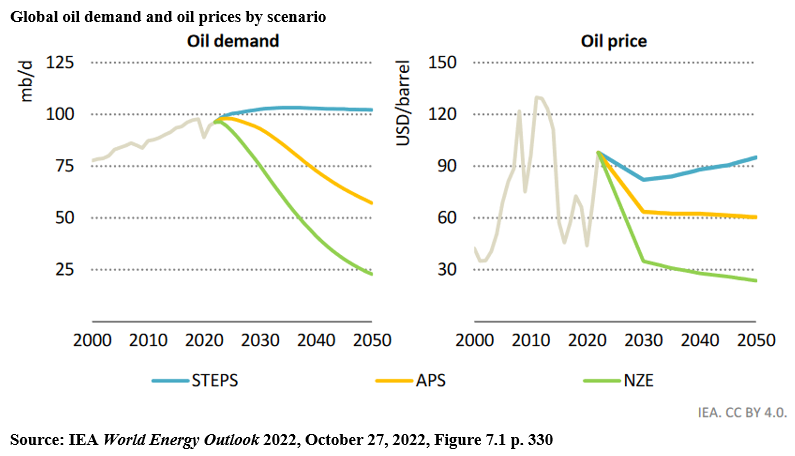The final part in a series of 18 discussion papers
The Canada Energy Regulator published its new report, Canada’s Energy Future 2022, on June 20, 2023. This is the first time the Federal Government’s energy agency has directly addressed whether the currently planned growth of oil production in Canada to 2030 and 2040 is compatible with keeping increased global warming to 1.5°C.
For the past nine years no environmental assessment or public inquiry process of any kind in Canada has ever answered that fundamental question. The question is highly consequential given Canada’s role as the world’s 4th largest oil producer and the accelerating impacts of global heating.
In recent years, studies by climate scientists have repeatedly shown that the current levels of global oil production put us on a pathway to a warming increase of 2.6°C by the end of this century. The International Energy Agency’s (IEA)“Net-Zero by 2050 Scenario” (NZE), which was first published in May 2021 (and updated in the IEA’s World Energy Outlook 2022 Report on October 27, 2022), warns about the immediacy of the need to halt any further expansion of oil production and provides detailed findings about the rapid pace and severity of the deep cuts in oil use needed as early as 2030 and deeper cuts required by 2040 to give the world even a 50-50 chance to keep the heating of the earth to within the 1.5°C threshold.

The IEA’s report includes the above graph which depicts the rapid decline of global oil production that would be required between now and 2050 to limit the rise in global average surface temperature to less than 1.5°C. It also compares two other scenarios which project much higher levels of continued oil use over the next two decades, neither of which are aligned with staying within the 1.5°C global heating limit.
The IEA’s Net-Zero Emissions by 2050 Scenario (NZE) determined that within this decade a 25% reduction in global oil production would be required, down to 72 million barrels per day (bpd) by 2030, and a 50% cut to 44 million bpd by 2040. It concluded that global production must decline to 24 million bpd by 2050 (a 75% reduction) to align with the 1.5°C goal. The bottom green line depicts the NZE Scenario, showing very deep cuts in the near-term by 2030 and 2040.
On July 8, 2021, a group of twenty-one energy economists and climate scientists sent a letter to Canada’s Prime Minister. It cited in detail the findings of the IEA’s May 18, 2021 “Net-Zero Emissions by 2050 Scenario” and was copied to the Minister of Natural Resources, Jonathan Wilkinson. They wrote: “Specifically, we urge you to mandate that the Canadian Energy Regulator model scenarios consistent with the IEA’s Net Zero by 2050 report”: i.e., instruct the CER to develop scenarios that will identify the much lower and declining oil production levels in Canada over the next 20 to 30 years that would be safely aligned with an effective global effort to stay within the 1.5°C warming threshold.
After refusing to do so for many years, on December 16, 2021, the government finally instructed the CER (formerly known as the National Energy Board) to carry out that study. The CER’s new report was publicly released on June 20, 2023. It offers three different scenarios.
Only the CER’s first scenario, which it calls its “Global Net-zero Scenario” (stated to be modelled on the IEA’s Net-Zero by 2050 Scenario), is aligned with limiting warming to 1.5°C. That would require a very dramatic reduction in Canada’s existing oil production levels which, according to the CER, was 4.9 million bpd in 2021 and reached a record 5.2 million bpd in 2022. Under the Canada Net-zero Scenario, starting after 2030 Canada’s oil production declines sharply to 2.8 million bpd by 2040 and falls to 1.2 million bpd by 2050.
The CER’s second scenario, the “Canada Net-zero Scenario”, envisions a much slower global transition away from oil. It assumes that after about 2040 countries will begin to adopt more stringent climate policies. Based on this assumption of ‘delayed’ action, the CER acknowledges that its second scenario aligns with warming of 1.7°C. But that rise in heating could be in the higher range of 1.8°C to 2 °C, depending on the actual timing and plausibility of promised future action to reduce reliance on oil, gas, and coal, which under this scenario will not even begin to happen for another 20 or 30 years. That gives Canada another few decades of higher oil production.
There is also a third scenario (the “Current Measures Scenario”) that leads to warming in the range of 2.6°C or 2.8°C. It assumes no significant new policies beyond those already in place.
The CER report offers no advice to the government suggesting which path we should follow or that we “cap” Canada’s oil production and align our future production level with the 1.5°C warming limit. It is silent about what we should do.
The position taken so far by the Federal Government is that it will adopt new policies to “cap’ emissions during the oil extraction process in Canada, but it will not limit production levels. The government’s plan is clear: Canada’s oil production will continue to increase until – and if – other countries eventually begin to consume less oil. In the meantime, Canada’s production levels will be guided solely by “global demand”.
Given that the Federal Government’s own energy regulator has now conceded that the NZE-aligned Global Net-zero Scenario is the only scenario that offers us any remaining chance to keep further warming within the 1.5°C threshold, the question is whether the government is prepared to abandon its approach that leaves these consequential decisions to the oil producers and their shareholders.
- Read the discussion paper: Driving Warming to 1.7°C and above: The new Canada’s Energy Future 2023 report and Canada’s projected oil production to 2050 (opens as a PDF in your web browser)